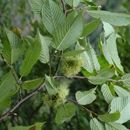Description
provided by eFloras
Trees to 20 m tall; trunk to 30 cm d.b.h.; bark dark gray or gray, fissured. Branchlets purplish brown, pubescent, sometimes stipitate glandular, glabrescent, with scattered, minute lenticels. Petiole 1-3.5 cm, densely pilose when young, glabrescent; leaf blade ovate-oblong, obovate-oblong, obovate, or elliptic, 5-15 × 3-9 cm, papery, abaxially bearded in axils of lateral veins, pilose and sparsely glandular, adaxially sparsely pilose especially along impressed midvein when young, base very obliquely rounded or subcordate, margin sharply and doubly mucronate serrate, apex long acuminate to caudate-acuminate; lateral veins 8-14 on each side of midvein. Male inflorescence ca. 2 cm; bracts broadly ovate, tomentulose, apex acute to acuminate; anthers purple. Female flowers 4-6 in a cluster; bracts campanulate, densely pubescent, sometimes stipitate glandular, with laciniate segments forming branching, pungent spines. Nut ovoid-globose, subcompressed, 1-1.5 cm in diam., apex pubescent. Fl. May-Jul, fr. Jul-Sep. 2n = 22.
- license
- cc-by-nc-sa-3.0
- copyright
- Missouri Botanical Garden, 4344 Shaw Boulevard, St. Louis, MO, 63110 USA
Distribution
provided by eFloras
Himalaya (Nepal to Bhutan), Assam, Tibet, N. Burma, W. China.
- license
- cc-by-nc-sa-3.0
- copyright
- Missouri Botanical Garden, 4344 Shaw Boulevard, St. Louis, MO, 63110 USA
Distribution
provided by eFloras
SE Gansu, Guizhou, W Hubei, Ningxia, Shaanxi, E and SW Sichuan, Xizang, Yunnan [Bhutan, NE India, N Myanmar, Nepal, Sikkim].
- license
- cc-by-nc-sa-3.0
- copyright
- Missouri Botanical Garden, 4344 Shaw Boulevard, St. Louis, MO, 63110 USA
Elevation Range
provided by eFloras
2600-3200 m
- license
- cc-by-nc-sa-3.0
- copyright
- Missouri Botanical Garden, 4344 Shaw Boulevard, St. Louis, MO, 63110 USA
Habitat
provided by eFloras
Forests on mountain slopes; 1500-3800 m.
- license
- cc-by-nc-sa-3.0
- copyright
- Missouri Botanical Garden, 4344 Shaw Boulevard, St. Louis, MO, 63110 USA
Cyclicity
provided by Plants of Tibet
Flowering from May to July; fruiting from July to September.
Diagnostic Description
provided by Plants of Tibet
Corylus ferox var. ferox is close relative of Corylus ferox var. thibetica, but differs from the latter in its scales of buds white villous (vs. glabrous), leaves ovate-oblong or obovate-oblong (vs. obovate or elliptic).
Distribution
provided by Plants of Tibet
Corylus ferox is occurring in Guizhou, SW Sichuan, NW and W Yunnan of China, Bhutan, Nepal, Sikkim.
Evolution
provided by Plants of Tibet
The phylogenetic relationships of the genus Corylus (Betulaceae) were investigated using sequences of the internal transcribed spacer regions of the nuclear ribosomal DNA and the chloroplast matK gene (Erdogan and Mehlenbacher, 2000). The two genes gave different results. In the ITS region, Corylus ferox formed the basal-most branch of the Corylus clades, the strict consensus tree was congruent with the results of interspecific hybridization relationships and morphological classification. Two clusters appeared on the strict consensus tree in the matK sequence, one with Asian and European species, and the other with North American species.
General Description
provided by Plants of Tibet
Trees to 20 m tall; trunk to 30 cm d.b.h.; bark dark gray or gray, fissured. Branchlets purplish brown, pubescent, sometimes stipitate glandular, glabrescent, with scattered, minute lenticels. Petiole 1-3.5 cm, densely pilose when young, glabrescent; leaf blade ovate-oblong or obovate-oblong, 5-15 cm long, 3-9 cm wide, papery, abaxially bearded in axils of lateral veins, pilose and sparsely glandular, adaxially sparsely pilose especially along impressed midvein when young, base very obliquely rounded or subcordate, margin sharply and doubly mucronate serrate, apex long acuminate to caudate-acuminate; lateral veins 10-14 on each side of midvein. Male inflorescence ca. 2 cm; bracts broadly ovate, tomentulose, apex acute to acuminate; anthers purple. Female flowers 4-6 in a cluster; bracts campanulate, densely pubescent, sometimes stipitate glandular, with laciniate segments forming branching, pungent spines. Nut ovoid-globose, subcompressed, 1-1.5 cm in diameter, apex pubescent.
Genetics
provided by Plants of Tibet
The chromosomal number of corylus ferox is 2n = 22 (Thompson et al., 1996).
Habitat
provided by Plants of Tibet
Growing in forests on mountain slopes; 1700-3800 m.
Corylus ferox
provided by wikipedia EN
Corylus ferox, the Himalayan hazelnut or Tibetan hazelnut, is a species of hazel native to the Himalayas of eastern Asia.[2]
Description
The Himalayan hazelnut is a deciduous tree growing to 32 m (105 ft) tall, with a monoecious leaf that can individually be male or female and some can be both sexes. The leaves are rounded or elliptic, 7–12 cm (2+3⁄4–4+3⁄4 in) long and 3–5 cm (1–2 in) broad, with a fine and sharply serrated margin and an often truncated apex. The flowers are wind-pollinated catkins and precocious. The male (pollen) catkins are pendulous with numerous solitary flowers and no perianth, while the female catkins are inconspicuous, 6-8 scaly buds and perianth adnate.[3]
References

- license
- cc-by-sa-3.0
- copyright
- Wikipedia authors and editors
Corylus ferox: Brief Summary
provided by wikipedia EN
Corylus ferox, the Himalayan hazelnut or Tibetan hazelnut, is a species of hazel native to the Himalayas of eastern Asia.
- license
- cc-by-sa-3.0
- copyright
- Wikipedia authors and editors

